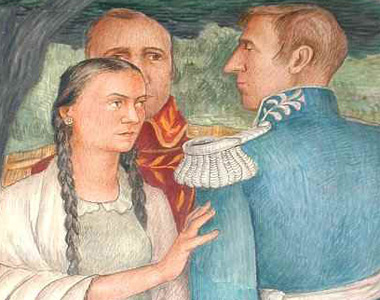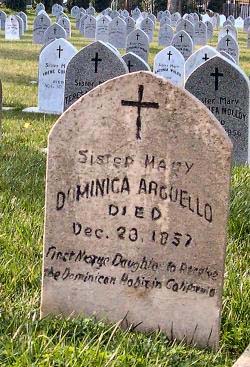
DONA MARIA DE CONCEPCION MARCELA ARGUELLO and Count Nikolai Rezanov, as depicted on a mural in the Post Interfaith Chapel at the Presidio of San Francisco.
nps.gov
They asked about Conchita. They loved the story of her famous romance with Count Rezanov and had visited the site of the Count’s grave in Russia, where they collected some soil. They had seen a rock opera about Conchita and the Count, called “Junona i Avos,” and read all the stories. After a tour of the museum I took them to the Dominican Cemetery and showed them her grave and memorial. It was a beautiful, crisp day. They were quite moved and took photos of me and the monuments. I left, and as I looked back I saw them spreading the soil from Russia and taking communion. I left them alone.
Museum curator Beverly Phelan tells me that once or twice a year, a Russian couple visits the museum and asks how to find the grave of Conchita, or Sister Dominica as she was later known. The reason for the pilgrimage is the Russian rock opera, which many say is to Russia what “Jesus Christ Superstar” is to the West. It opened in 1981 and the Moscow presentation of the opera is the second-longest running theater presentation in history, after “The Fantasticks.”
The opera, which opened in the darkest hours of the Cold War, is about a 19th-century Russian count and a young Spanish California woman, featuring singing actors in Czarist and Spanish colonial uniforms. It is one of the very few times in Soviet Russia that the two-headed Czarist eagle banner was displayed on stage.
The opera is, in fact, about Count Nikolai Rezanov and Conchita Arguello, the 15-year-old daughter of the Spanish commandant of the Presidio in Yerba Buena — now San Francisco — in the first decade of the 19th century. The story, passed down in Spanish California lore and romanticized by later American authors, has Nikolai visiting San Francisco harbor, falling in love with Conchita and asking for her hand, her father saying only if the Czar permits, Nikolai returning to Russia to obtain permission but dying on the way, and the broken-hearted Conchita becoming a nun. She is buried in Benicia — thus the local connection.
Now a new book puts the Rezanov-Arguello love affair — if it was truly love — in 19th-century geopolitical terms. “Glorious Misadventures: Nikolai Rezanov and the Dream of a Russian America,” by Owen Matthews (Bloomsbury, N.Y., $28), is a good read on several levels, a well-documented history and a swashbuckling adventure tale — just don’t look for it to be a soppy love story.
Nikolai Petrovich Rezanov was not, it turns out, a count. He was a Czarist-Russian aristocrat who rose to a position of influence within the St. Petersburg royal court by becoming the assistant to Grigory Orlov, the last and perhaps most influential of Catherine the Great’s gigolos. Rezanov worked his way up the military and aristocratic ladder by aligning himself with various mentors and, in turn, mentoring others. Finally, he was in a position to influence Czar Paul, the “dwarfish and paranoid” son of Catherine, to create a company fashioned after the Dutch East India Company and the British East India Company. As an agent for the Russian-American Company, Rezanov set off to cross Siberia and travel the Pacific, exploring for raw materials and markets.
The Dutch and English had found a superb method of colonial conquest: by going public and creating the first stock companies to capitalize on the financial rewards and efficiencies of capitalism. The Spanish, Portuguese and French, on the other hand, created great bureaucracies to populate and exploit their colonies — and suffered the resulting inefficacies and corruption. The Russians, in creating their new stock company, hoped to duplicate the Dutch and English capitalistic successes — ironic in that capitalism wouldn’t truly come to Russia until the 21st century.
Matthews does a fine job tracking Russian economic expansion east to the Pacific in the search for furs and minerals. The campaign took Russian aristocrats, and sometimes not-so-willing volunteers, through Siberia, into Alaska and around the Pacific. There was competition. The Dutch had already made inroads in Indonesia and the South Pacific and had established an extremely lucrative trading center in Nagasaki, Japan. The French had established colonies in Polynesia and the British in Australia and Vancouver, Canada. Looking at Spanish California — ruled by a distant and corrupt king and managed by a bureaucracy of indifferent viceroys and governors — the Russians saw a ripe fruit that might be picked from the tree.
Nikolai Rezanov left his base on the Kamchatka Peninsula in a ship, the Juno, in the early summer of 1805 for what was basically a shopping trip. The plan was to inspect the existing Russian trading posts in the Aleutian Islands and Alaska and to establish new markets in the Pacific. It was a plan that was doomed to failure. His boat leaked, his entourage of aristocrats were unaccustomed to long voyages, and his basic business model could be summarized as “too little, too late.” His ship made landfall in Japan but he was rebuffed by the Japanese, who already had a successful and lucrative 200-year trading arrangement with the Dutch.
On the Sandwich Islands — now Hawaii — Rezanov was greeted by a friendly and cooperative monarchy, but he was unable to turn the positive reception into profitable trading concessions. The British and the Americans had arrived before him. By the time he sailed into San Francisco Harbor on March 28, 1806, he and his crew were disillusioned, half-starved, scorbutic and plagued by lice. They were greeted enthusiastically by the California residents of Yerba Buena, who were most likely bored with provincial life.
The Californios were gente de razon, Spanish Creoles of pure European blood. Their culture was centered on the family and their economy was based on agriculture and trade in tallow and hides — the famous “California dollars.” So it must have been exciting indeed to see such a rare spectacle as Rezanov, dressed in his imperial Czarist uniform and bemedaled with impressive diamond and gold awards, and his entourage, and they rolled out the warmest and most formal welcome they could. And it was at an official reception that Rezanov met Doña Maria de Concepcion Marcela Arguello, known to her family and history as Conchita.When Nikolai Rezanov met Conchita at the still-standing officers’ club at the Presidio, he was 42 years old and suffering from the foul breath, loose teeth, poor eyesight and intense rashes of scurvy and malnutrition. It took some time for the local wines, brandies and fruits to provide the vitamins that he and his crew needed to recover. But, his uniform, awards and courtly manner impressed his hosts, and he was a good dancer, then — as now — an attraction to women. (Memo from an old guy to teenagers: Men who can dance are babe magnets.)
Conchita was 15 years old and, reportedly, intelligent and beautiful, with fine features and a light complexion. She could also read and write, rare for a woman in Spanish California, where women were expected only to tend the home and bear children. Matthews suggests that Conchita saw in Rezanov a chance to escape her eventual fate of being married off to a Spanish Californio and isolated in Yerba Buena for the remainder of her life. Conchita, he theorizes, wanted more. She and Rezanov started seeing each other in the formal atmosphere of Spanish courtship, which meant rendezvous in the family kitchen, where there were plenty of female relatives in attendance, and walks along the seashore attended by yet more female chaperones.
Marriage in the Russian aristocracy and royal courts was looked upon as a political tool for advancement. Men sought out women who were members of politically connected families to advance their status. Powerful families often used their daughters as a means of forging alliances with other connected families. The same was true for the Spanish Creole families of 18th- and early 19th-century California.
The book’s author suggests that while Conchita saw an opportunity to break free of her fate in Spanish California, Rezanov saw a chance to establish a political alliance with the Californians. Matthews suggests that they may actually have fallen in love with each other and that Rezanov may have meant it when he said he would return to marry her. It must have been a great day by the bay.
But he didn’t. Rezanov died in Krasnoyarsk, halfway across Russia, on his return to Moscow and St. Petersburg. At the time he had an impressive grave but, reminiscent of England’s unfortunate King Richard III, his burial place now is said to lie under the parking lot of a railroad station. The local city council, hoping to capitalize on tourists who saw “Junona i Avos,” has erected an enormous bronze statue of Rezanov at the site.
Rezanov’s long and detailed reports continued to their destination and contributed to Russia’s plans to establish more trading posts in the Pacific, including Fort Ross. The love story of Conchita and the Count was romanticized by authors Gertrude Atherton and Bret Harte in the second half of the 19th century and eventually became one of the first California fables.
Conchita became California’s first native-born nun and took the name of Sister Dominica, the name on her gravestone. She enjoyed the respect of her peers in Spanish, Mexican and American California. She concentrated on education and wrote California’s first textbook. When the Dominican Order moved to Benicia, she moved with them, and here she died in 1857. She is buried in the Dominican Cemetery on Hillcrest at the northern end of East Fifth Street.







Leave a Reply